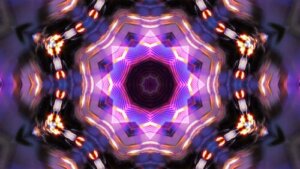Why Does Kaleidoscope Vision Occur?


Written and verified by the doctor Mariel Mendoza
Kaleidoscope vision is a visual illusion created by the brain in which you can see bright or fractured colors, similar to those that can be seen through this object. It occurs as one of the auras of retinal migraine, but may also be associated with other more serious pathologies, such as transient ischemic attacks and retinal detachment.
The term aura refers to sensory disturbances that may occur prior to the onset of a migraine headache. Kaleidoscope vision isn’t the only associated visual disturbance, as blind spots or bright lights may also be seen.
Auras or sensory disturbances may affect up to 20% of people with migraine. They precede the pain and last approximately 30 minutes, although they can last anywhere from 5 minutes to 1 hour.
The headache usually occurs 10 to 15 minutes after the aura.
What is kaleidoscope vision?
Kaleidoscope vision is an illusion produced by alterations in the visual cortex of the brain. Colors are brighter or fractured and sometimes images move.
It can affect one or both eyes, as well as only part of the visual field or the entire visual field.
It’s the result of a sudden increase in neuronal activity and occurs with or without pain. The medical term is scintillating scotoma.
Visual or ocular migraine is the main cause of kaleidoscope vision. However, it can also occur in retinal migraine, strokes, or due to hallucinogen use.

Ocular migraine
The so-called visual or ocular migraine is due to structural abnormalities in the neurons of the visual cortex. It may take up to an hour after kaleidoscope vision to experience the headache. As in other cases, there may be no headache, which is called acetalgic migraine.
Sensory disturbances usually last between 10 and 30 minutes, but may extend for 1 hour. In addition to being caused by structural abnormalities of the visual cortex, they may be due to binocular visual dysfunction (improper alignment of the eyes).
Retinal migraine
Although it can be confused, a retinal migraine as a cause of kaleidoscope vision has similar symptoms, although the origin is different. It’s a response to reduced blood flow to the retina, so the symptoms are unilateral.
In addition to kaleidoscope vision, it causes flickering lights, blind spots or temporary blindness. The associated headache is throbbing and occurs in the middle of the head on the side of the affected eye.
In visual or ocular migraine, the distorted image is in both eyes. In retinal migraine, it’s in only one eye.
To be sure if both eyes are affected, it’s recommended to cover one eye and then the other. If both eyes are affected, the image is distorted in each eye separately.
Stroke (CVA)
This is caused by blockage of blood flow to the brain. It may be associated with damage to the blood vessels, blood clots blocking the passage, or a narrowing due to the presence of plaques with fatty deposits.
It’s known as a transient stroke is a temporary blockage in which symptoms last from a few minutes to a maximum of 24 hours. Following a stroke or transient ischemic attack, there’s a high probability of having another stroke in the future.
Any symptoms of a stroke should be reported to doctors immediately. Symptoms vary widely and include the following:
- Confusion
- Difficulty speaking
- Loss of consciousness
- Loss of balance and dizziness
- Tingling or numbness on one side of the body
Find out more: 6 Tips to Help You Prevent a Stroke
Hallucinogen use
Lysergic acid diethylamide (known as LSD) and mescaline produce visual distortions with the presence of very bright, but unstable, colored images that can resemble what is visualized when looking through a kaleidoscope. This is why the consumption of hallucinogens should be ruled out as a cause.
Kaleidoscope vision is an altered visual aura
The different types of visual aura change the way in which the person visualizes his or her surroundings.
There are three variants:
- Positive visual aura: Where an image is visualized that isn’t actually there. It can be zigzag lines, squiggles, flashes, or dots.
- Negative visual aura: There’s a loss of vision that can be partial or total, i.e., ranging from blind spots or loss of peripheral vision (tunnel vision) to a brief period of total loss of vision.
- Altered visual aura: In this variant, what is visualized is distorted, without adding or subtracting anything. Objects are seen as a straight, wavy, or blurred line. Perception of object size, distance, and color may also be changed.

There’s no specific treatment for kaleidoscope vision
Currently, there’s no cure for migraines. Kaleidoscope vision, like any other associated symptom, usually disappears within 1 hour. However, medications can be given to prevent or relieve the headache. Sitting or lying down in a dark, quiet room, massaging the scalp, and using a warm compress on the forehead are also recommended.
Over-the-counter pain relievers, such as ibuprofen, are helpful. In some cases, beta-receptor blockers or calcium channel blockers are indicated.
Find out more: What is an Ophthalmoplegic Migraine?
It’s a scary symptom
Kaleidoscope vision can be frightening, especially the first time it occurs. However, it usually subsides within a few minutes, so relax and wait for your vision to return to normal before walking, driving, or operating machinery. The causes of ocular migraine vary from person to person. On many occasions, they can’t be determined.
Some foods, such as caffeine or chocolate, as well as stressful conditions, can be triggers.
[/atomik-in-text].An ophthalmologist should always be consulted if kaleidoscope vision is present.
All cited sources were thoroughly reviewed by our team to ensure their quality, reliability, currency, and validity. The bibliography of this article was considered reliable and of academic or scientific accuracy.
- Friedman D. Visual disturbances: Related to migraine or not. American Migraine Foundation 2016. Disponible en americanmigrainefoundation.org/understanding-migraine/visual-disturbances-related-to-migraine-or-not/
- National Institute of Neurological Disorders and Stroke. Migraine. National Institute of Neurological Disorders and Stroke 2019. Disponible en https://www.ninds.nih.gov/Disorders/All-Disorders/Migraine-Information-Page.
- Swanson J. Ocular migraine: when to seek help. Mayo Clinic S.F. Disponible en mayoclinic.org/diseases-conditions/migraine-headache/expert-answers/ocular-migraine/faq-20058113.
- The International Classification of Headache Disorders. Retinal Migraine. ICHD S.F. Disponible en https://ichd-3.org/1-migraine/1-2-migraine-with-aura/1-2-4-retinal-migraine/.
This text is provided for informational purposes only and does not replace consultation with a professional. If in doubt, consult your specialist.








